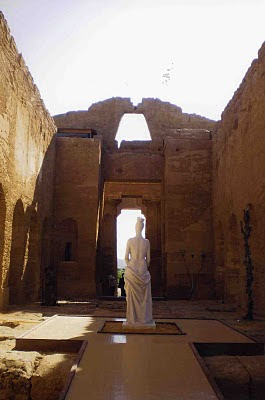
The gigantic Temple of Olympian Zeus, Agrigento, was damaged by earthquakes before completion. This new statue, a flying bronze, echoes the temple’s fallen state. The wing overlaps and seems to touch a huge Doric capital to the right of the middle.

I was recently in Sicily to view mainly the ancient Greek sites. My camera broke and thankfully Kelli Palmer is letting me share her pictures of Agrigento, a city known for the beauty of its golden limestone.
The Temple of Concord in Agrigento is one of the best preserved Greek temples standing today, probably due to the fact that it was used as a church in the Middle Ages. Right now contemporary sculpture is on display there and at the other temples in Agrigento. The combination of antique/modern — though not always successful — is particularly well done at this site because it does not detract from the ancient architecture while displaying the new work effectively. The sculptures seem to be made for this purpose.
porch of a 5th century BC Doric temple. It is
not known to whom the temp
 le wasdedicated.
le wasdedicated.
into a church’s nave.


After visiting Selinunte and marveling at the scattered ruins of the temples, I am awestruck at the magnificent well preserved temple of Concord, perched on the hillside. As you remember, I had the good fortune to work some days at the Marsala archeological museum where a lot of Punic, Roman and Medieval artifacts are stored We also made a side trip to Mozia, which later became an important naval base and landing site for the Carthaginians who set about conquering the island and ransacking sites like Selinunte and Agrigento.
The fondest memories I have are of meandering through the acropolis at Selinunte and imagining life as it must have been back then. Unlike, Agrigento, the surroundings views at Selinunte of the Mediterranean are less developed and unobstructed. After a long day of walking through the ruins at Selinunte, we ended up sitting and resting on one of the ancient walls looking out onto a beautiful, unspoiled view of the ocean.
Thanks for bringing back these memories.
JL.